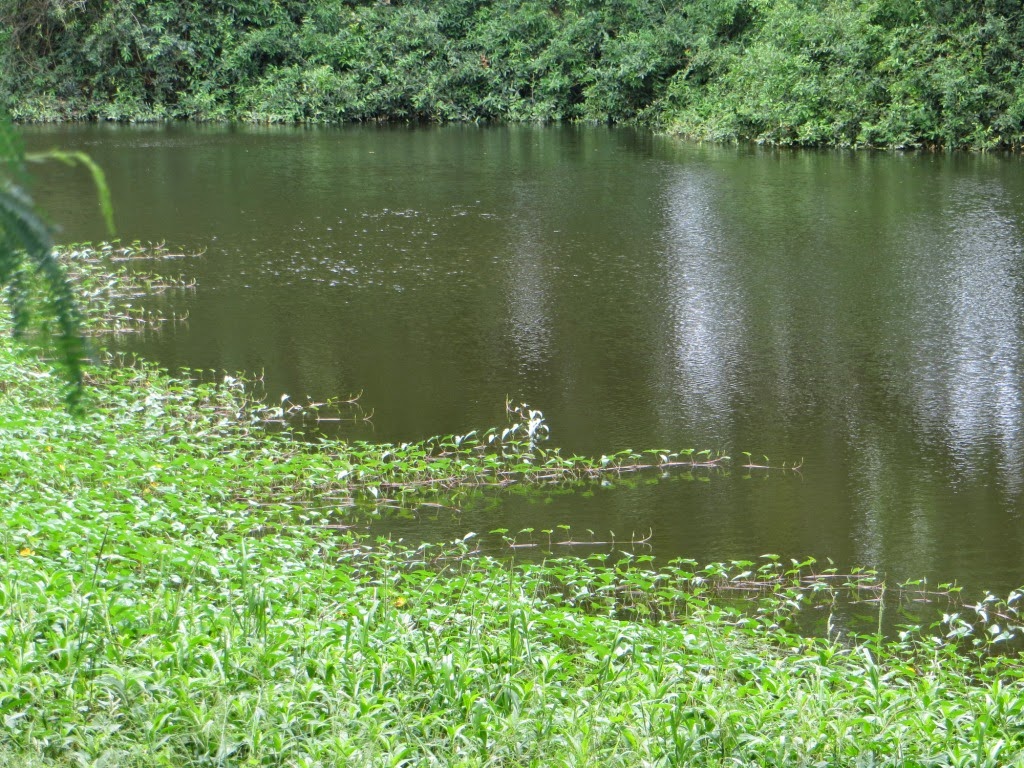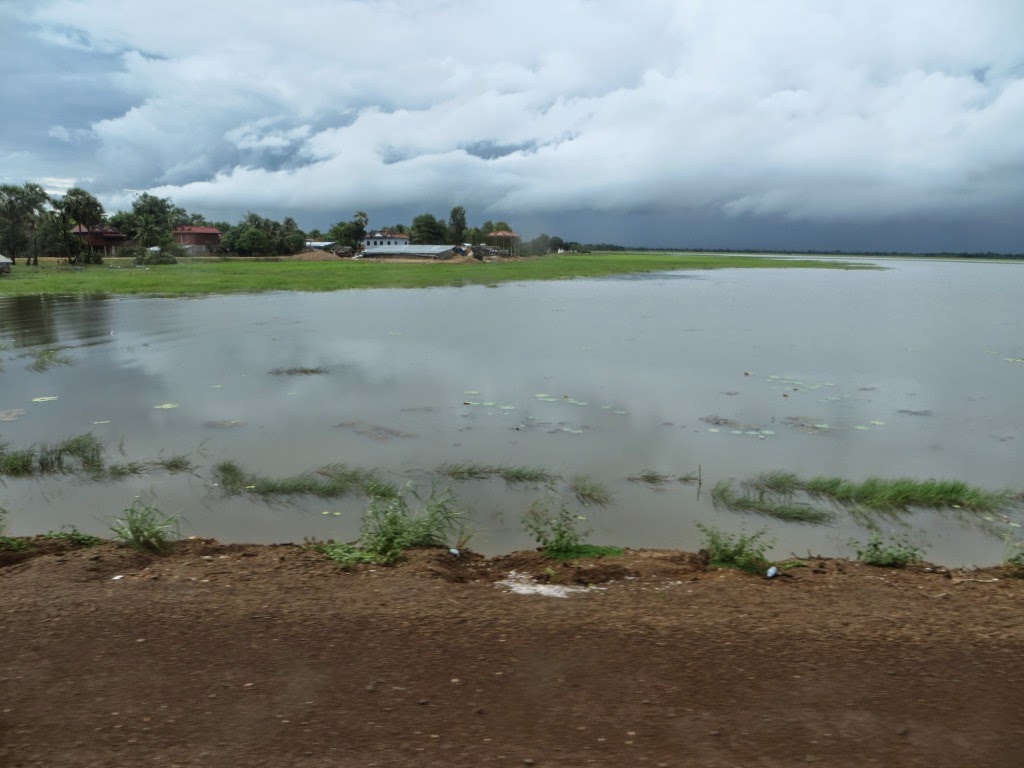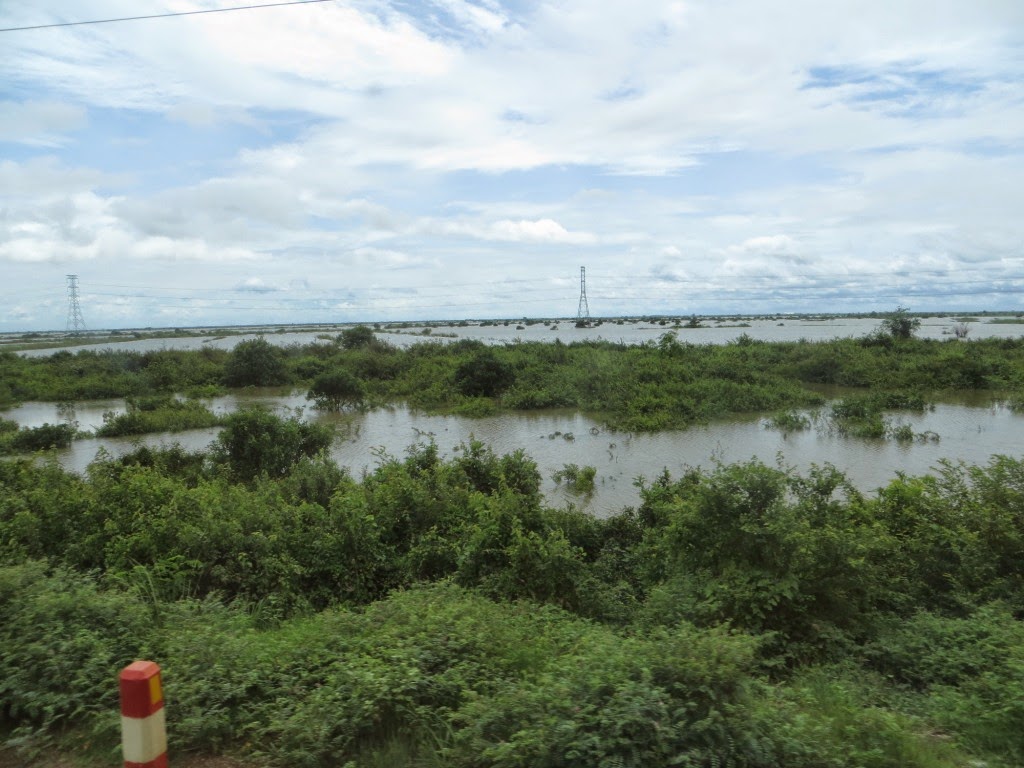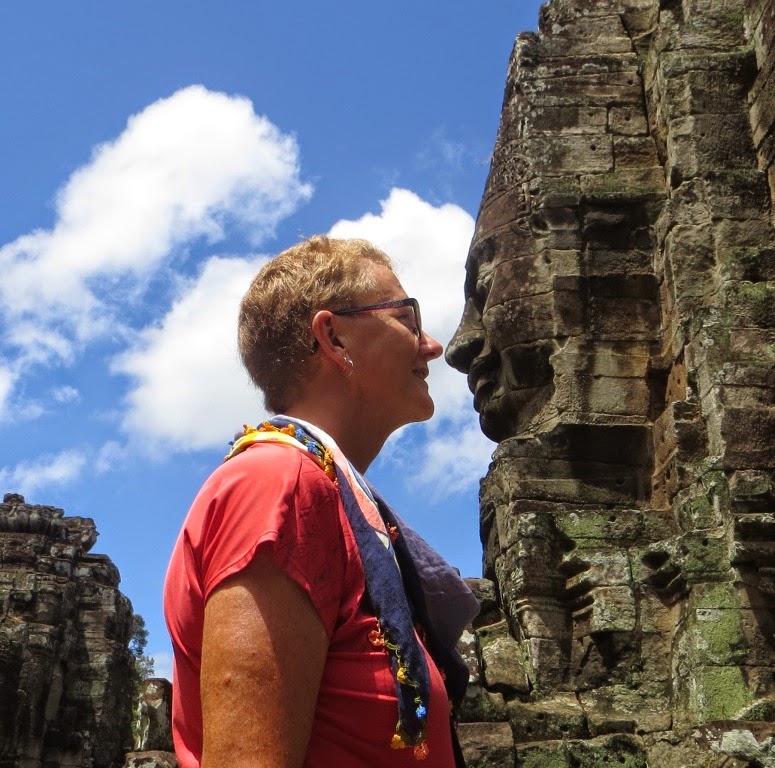We spent five days in Cambodia; two of which were travel days. As for the other countries of southeast Asia, we didn’t get a chance to truly experience Cambodia.
 |
| From the ferry over the Mekong river. This is how you build a suspension bridge - from both sides into the middle! |
 |
| Ronald MacDonald, Phnom Penh |
 |
| Poster in the bathroom at our hotel. Interesting |
 |
| Typical Khmer headscarf. Cotton and plaid. I found it interesting that I could NOT buy this. I could get table runners, scarves in silk, but not the real thing. |
Where Laos is struggling with UXO (unexploded ordinance) and Vietnam is dealing with the ongoing effects of Agent Orange, Cambodia is working to recover from the insanity of decades of civil war and the three years of Khmer Rouge rule. As for the Vietnam war, I was vaguely aware that Cambodia was another one of the countries affected but did not grasp the full extent of what was happening. Somewhere between 1.7 and 3 million people were tortured and murdered, or starved, or otherwise “disappeared”. All infrastructure (including hospitals and schools) was destroyed and families were separated. Since 1980, the country has struggled to rebuild, to provide education and employment for their people and to recover from the losses that were inflicted.
We were blessed with being able to visit Cheung Ek and Tuol Sleng on our one day in Phnom Penh. There are over two hundred “killing fields” and torture sites known in the country, but the reason why this is the one chosen to be remembered is that incredibly detailed documents exist of who was tortured (including their confessions) and then killed. When the Vietnamese discovered Tuol Sleng, they photographed everything. Other sites do not have the records that remain here. Indeed, some sites are not safe to explore because landmines remain. For almost 20 years after their defeat, the Khmer Rouge operated out of bases just inside the Thai border and continued the war – along this border it remains very unsafe to stray off the main roads.
The Cambodian people/government are choosing to remember the events of 1975 to 1979 for two reasons. First, they have a strong belief that if people are not respectfully buried and remembered, then their spirits will remain restless. Cheung Ek is a place where families can come to remember their ancestors killed during that time. Second, they hope by remembering that others will learn from the genocide. Everybody in Cambodia was affected and it was truly humbling to hear the stories of our guides. I was taken by one description of how Pol Pot was able to conscript poor, hungry and illiterate peasants by promising them food and a sense of belonging – exactly the same strategy used today with Boko Haram in Nigeria as well as countless other groups across the ages.
Phnom Penn
(read more about Cheung Ek and Tuol Sleng)
I chose to take photos that were respectful of the victims. There are many sites that will give you more details. I won’t say that I had a great day, but it was moving and I am very glad that I visited the sites. If there is only one thing you can do when you are in Phnom Penh, this should be it.
 |
| Memorial Stupa. Inside are the bones/skulls of about 6000 of the victims. Bones are still surfacing from the mass graves and respectfully interred here. |
 |
| a place to reflect Our audio guide had music composed specifically for Cheung Ek |
 |
| Memorials left on a tree where babies were murdered then thrown into the neaarby attached grave with their mothers |
 |
| Nearby spirit house. A place for unsettled spirits to find peace |
 |
| Tuol Sleng was originally a local school |
Onward to Siem Reip
 |
| Ladies selling their wares outside our bus |
 |
| This lady was selling fabric for sarongs. Lots of fabric coming out of this bag and being admired by the other ladies (and me) |
 |
| view from the left side of the bus |
 |
| view from the right side of the bus. Yes, we are travelling through the lake |
As we travelled to Siem Reap, the road travelled through marshy water logged landscapes. Houses were on stilts and people were practicing subsistence agriculture. Everything, of course, was new and well cared for because thirty years ago there was nothing. Siem Reap was the capital of the Khmer empire from about the third to fifteenth century. At its strongest, the Khmer ruled all of Vietnam, most of Thailand and into Malaysia. They were originally from India, and it can be seen in the people today. Their alphabet is sanscrit as well. In the 1600s, the Khmer were defeated, finally, by Thailand and the entire province was deserted. Siem Reap means “Thailand defeated us” and our guide explained that the local people moved away to safer locations. Angkor Wat was rediscovered in the 1850s.
We spent one day visiting as many of the temples as we could by tuk tuk, but only touched the surface. The next day, we visited the Angkor Museum; an excellent explanation of history and culture of the Khmer people. It was fascinating to see how this civilization allowed both Hindu and Buddhism to coexist, often in the same temples. The Buddhist apsaras that we first met in China are actually originally Hindu and were courtesans of the gods. Most of the temples pay homage to Naga (a cobra and a protector) as well as a birdlike figure, Geruda. Both these figures are common to the two religions. The Peace Stup at Cheung Ek has both Naga and Geruda (traditionally enemies) which is symbolism for peace.
 |
| Geckos are everywhere. The lighting was perfect. |
Our hotel was owned by a fellow who was orphaned by the Khmer Rouge, managed to escape with others over the border to Thailand and sent to New Zealand where he grew up. He returned as an adult to help rebuild his country. All the staff are young people from rural areas that learn skills to be able to support themselves and their families. I am trying to imagine what it was like as a five year old, having lost all his family, and fleeing through jungles that were heavily mined. Then to be sent to a country completely different from what he was familiar with.
Angkor Wat (and others)
I was fascinated by the shapes and textures of the temples; particularly the contrasts of the green plants with the blackened aged stones. Here are some of the dozens of photos I took at Angkor Wat, then Ta Prohm (which is being gradually restored rather than allowing the jungle to take over), Bayon in Angkor Thom, and then Preah Khan. Preah Khan was on our own (with Wayne and Keith) as others had been templed out. Our tuk tuk driver was delightful – many are working at getting qualified to become guides, so they enjoy practicing on tourists what they are learning.
 |
| Bomb crater on the entrance walkway to Angkor Wat. Our guide said we would see them everywhere |
 |
| Library in the background. There were two, one for men and one for women |
 |
| "Poor lions" used to have copper tails which were scavenged by local people and sold for food |
 |
| Apsaras - Hindu celestial nymphs |
 |
| still very much an active temple |
 |
| this turtle was looking very dead on the walkway. but when our guide picked him up to move him to the grass he very indignantly and quickly hopped away |
 |
| Ta Prohm One of the temple urchins |
 |
| worker hacking away the growth that is trying to reclaim the temple |
 |
| Bayon in Angkor Thom One of the youngest temples |
 |
| 59 faces originally. One for each of the major cities in the empire. Some of the towers have been lost. |
 |
| Each face is unique |
 |
| bats on the roof thanks to Dave for taking the photo I couldn't see them :) |
 |
| Heading off with "our" tuk tuk driver |
 |
| elephants at the gates |
 |
| All the entrances here have the creation story depicted (good and evil tug of war with Naga the snake as the rope) |
 |
| Molds give great quilty images. |
Near the entrance was a young man selling temple rubbings. He said that he had learned the skill from his father and grandfather. The paper is traditional rice paper and then colour is added – for mine it is the traditional charcoal mixture rather than modern paint. I actually saw the wall sculpture he used in Angkor Wat showing the daily life of the common people, complete with an elephant. Cal is making suggestions that we will need to add an addition to the house for all the street artwork I am finding.
 |
| the artist -Sao which means Saturday. He wasn't born on Saturday, but his dad's name means Friday. |
As we were travelling through Cambodia, two books I had recently read were running through my mind. Sue Downie’s “Down Highway One” describes arriving in Cambodia just as the Vietnamese were liberating the country (she was much more the intrepid tourist than I). The second is Brian Thacker’s “Tell Them to Get Lost: Travels with the Lonely Planet Guide that Started it all”. While retracing the route that the original Lonely Planet authors used, he actually visited Angkor Wat with the protection of the army.... If you can’t visit Cambodia, check out these two books. I first heard about Sue Downie on an Australian quilting blog (the Thread Studio) and it is available in Alberta through interlibrary loan. Thacker’s book was found as an ebook on Kobo.






















































No comments:
Post a Comment